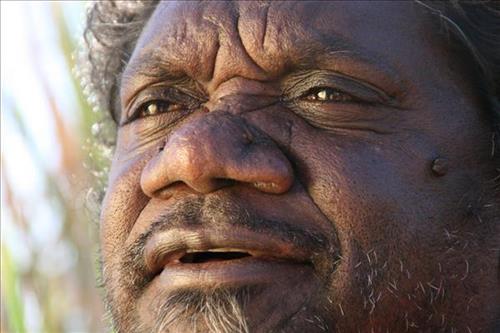111581905551
Niminjarra (Paji)
“Niminjarra is the two brothers transforming into a snake so they can go back home to Ngayartakujarra (Lake Dora). They were in training for ceremony, those two brothers, but they were kept too long and nobody was there to release them. They waited then they decided to transform into snakes to travel back to where they came from, because their mother was waiting for them. This is Jukurrpa (Dreaming story)
Here the Jila Kujarra are travelling from the East, coming West, gliding over Paji waterhole, near the lake district of Ngayartakujarra (Lake Dora).”
– Desmond Taylor
The term jukurrpa is often translated in English as the ‘dreaming’, or ‘dreamtime’. It refers generally to the period in which the world was created by ancestral beings, who assumed both human and nonhuman forms. These beings shaped what had been a formless landscape; creating waters, plants, animals, and people. At the same time they provided cultural protocols for the people they created, as well as rules for interacting with the natural environment. At their journey’s end, the ancestral beings transformed themselves into important waters, hills, rocks, and even constellations.
Jila Kujarra (Two Snakes) is one of the key jukurrpa narratives for the Martu. Though the story belongs to Warnman people, it is shared across the Western Desert with several other language groups. The narrative centres on the travels of two snakes as they are pursued by the Niminjarra, spiritual ancestors of the Warnman people. Before transforming themselves into snakes, the Jila Kujarra were young brothers waiting to be released from ceremony at the boundary of Mukurtu, west of Mamunara (Canning Stock Route Well 28). They began travelling home to their mother in the west, but were intercepted by the Niminjarra as they hunted and hurled their spears in front of them. Suddenly the spears of the Niminjarra stuck in the ground and swayed in the air, alerting the Niminjarra to the tracks of the Jila Kujarra.
The Niminjarra started to track the Jila Kujarra, but stopped with their many weapons at Jantuwurujul (or Janturuly) to hunt for wild game. The Jila Kujarra continued to flee, reaching Paji, east of Nyayartakujarra (Lake Dora) before they were again intercepted by the Niminjarra. The Niminjarra believed the snakes had hidden in a cave north of Paji, and tried to smoke them out. Again, the Jila Kujarra eluded their pursuers, this time escaping under the lake at Paji and at the same time creating many small decoy snakes to lead the Niminjarra astray.
Meanwhile, from a nearby hill, two Pukurti (initiates with bundled hair) prophesied that the Niminjarra would kill the Jila Kujarra. The Pukurti tracked the Jila Kujarra through to Nyayartakujarra, where they speared the snakes in the head to hold them down while they returned to Paji to summon the Niminjarra. The Niminjarra made a fire and cooked the snakes at Ngayartakujarra (Lake Dora). The snakes were too long to lay down on leafy branches to be cut up, so the Niminjarra lay down to make a human table. When the Niminjarra cut down the length of the Jila Kujarra, the snake’s bladders were pierced, causing an explosion of scalding hot urine in which the Niminjarra all perished and became black rocks at the site. At the same time, the urine of the Jila Kujarra formed the vast salt lake, Kumpupirntily, which translates to ‘bladder burst’.
The spirits of the Jila Kujarra rose and continued to travel to their mother at Nyayartakujarra. She saw them coming towards her as flaming figures, and called out to them, piercing the surface of the salt lake with her digging stick. There, the mother and her sons entered the ground below Nyayartakujarra, where they remain to this day.




